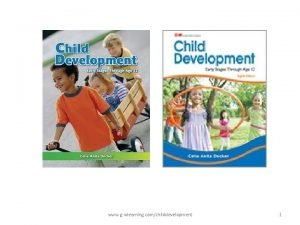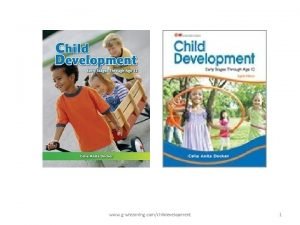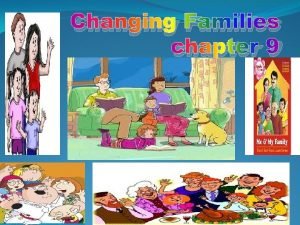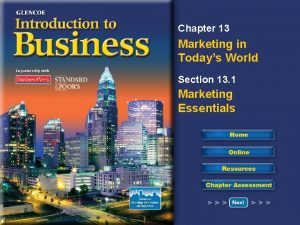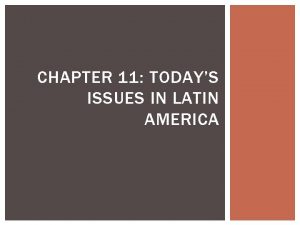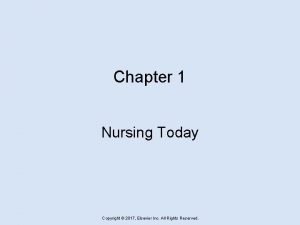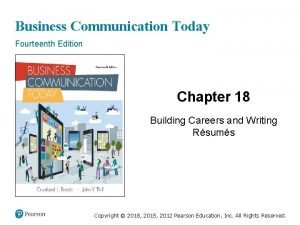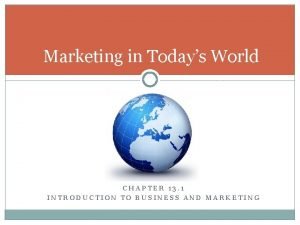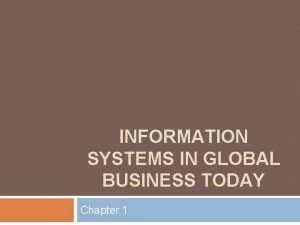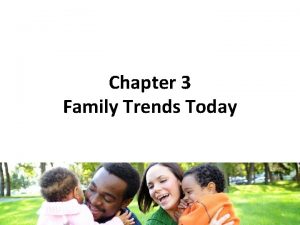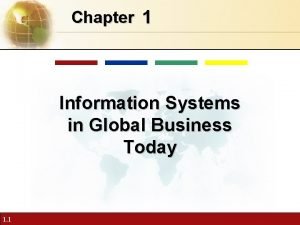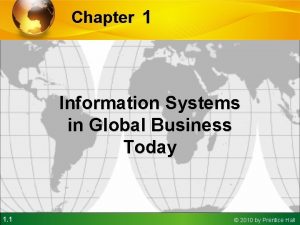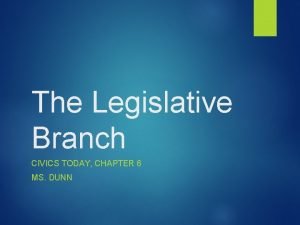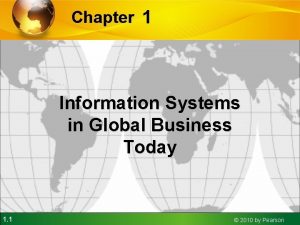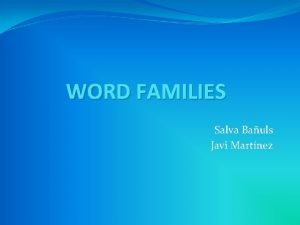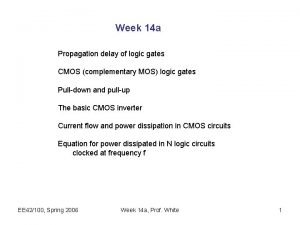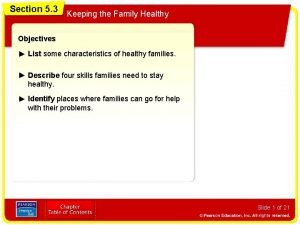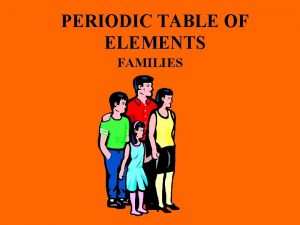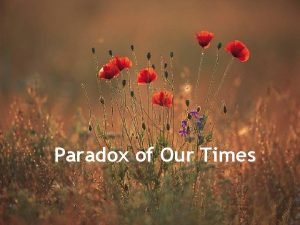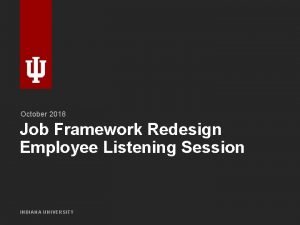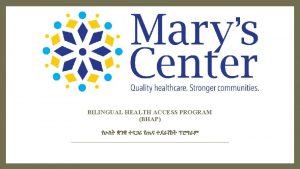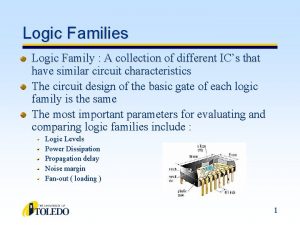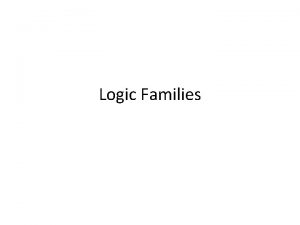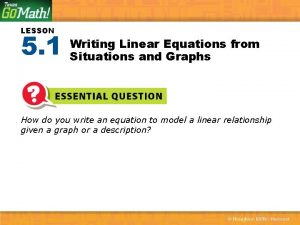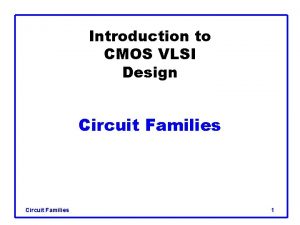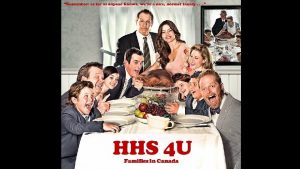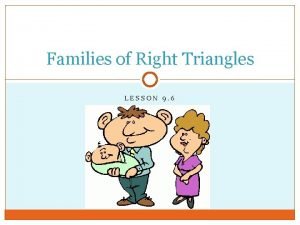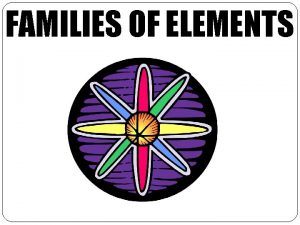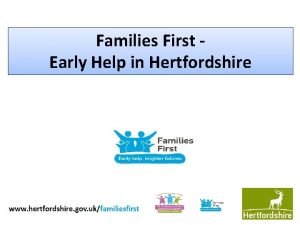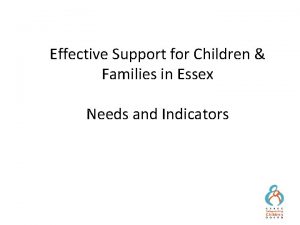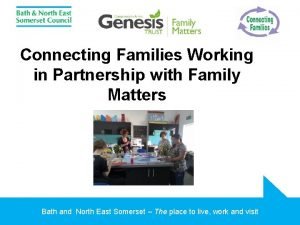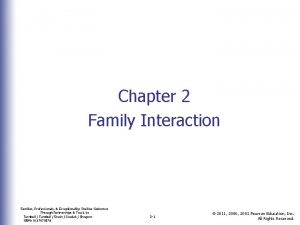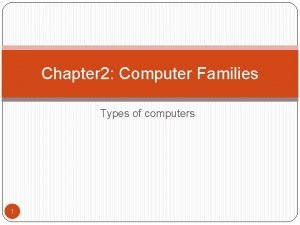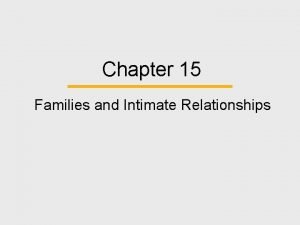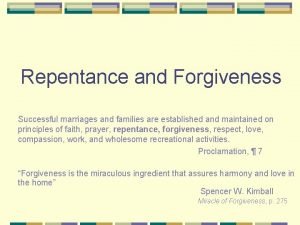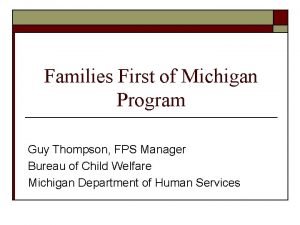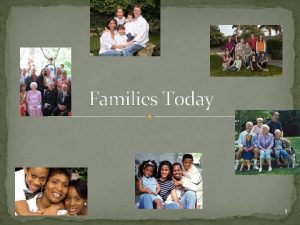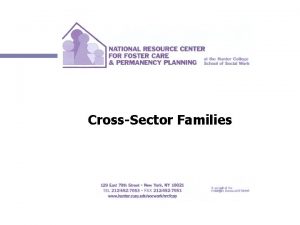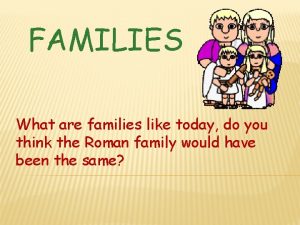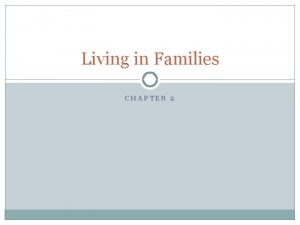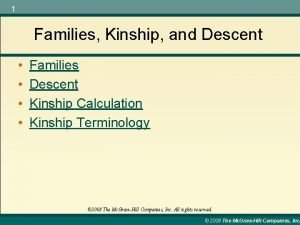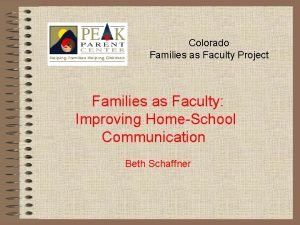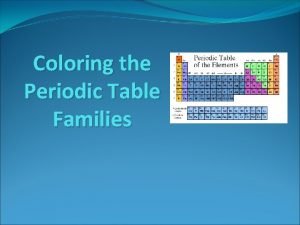www gwlearning comchildevelopment 1 Chapter 3 Families Today










































































- Slides: 74

www. g-wlearning. com/childevelopment 1

Chapter 3 Families Today www. g-wlearning. com/childevelopment 2

Lesson 3. 1 Healthy Family Development www. g-wlearning. com/childevelopment 3

Key Terms • • • Active listening Body language Budget Communication Cultural diversity Culture Family life cycle Marriage Multicultural family Premarital counseling www. g-wlearning. com/childevelopment 4

Lesson 3. 1 – Guided Notes Write the questions on your paper and answer as you take notes. 1. Define marriage and explain its functions and importance in family life. 2. Explain the difference between nonverbal and verbal communication, and give an example of both. 3. How is a budget important to a healthy marriage and family? www. g-wlearning. com/childevelopment 5

Lesson 3. 1 – Guided Notes 4. Name the seven stages of the family life cycle. 5. ____ is a way of life within a group of people that include language, beliefs, attitudes, values, rituals, and skills. 6. Describe some of the unique challenges of being part of a multicultural family. 7. How do societal views of children today differ from societal views of children before and during the Industrial Revolution? www. g-wlearning. com/childevelopment 6

• The family is the oldest known social group. • Healthy families work on building healthy relationships. • Families, just like individuals, change through the years, but continue to be the basic unit of society. www. g-wlearning. com/childevelopment 7

Building a Strong Foundation • The strength of a family's foundation depends on the strength of its inherent (basic) relationships. • Building a strong foundation, whether in marriage or other key relationship, is essential to the satisfaction of family members, the stability of the family unit, and the health and development of any children. www. g-wlearning. com/childevelopment 8

Considering Marriage • Marriage is a legal contract and, ideally, an emotional and social union between two partners. • In a healthy marriage, both partners desire to remain together and both partners feel satisfied, even if conflicts and periods of discontentment (unhappiness) occur. www. g-wlearning. com/childevelopment 9

A happy marriage can be a source of love and security for two partners, as well as a source of stability and comfort for a couple’s children. www. g-wlearning. com/childevelopment 10

• Factors to consider before getting married. –Why do I want to get married? –When do I want to get married? –What qualities would each partner bring to a marriage? –Do we have similar life goals and values? www. g-wlearning. com/childevelopment 11

Marriage Evaluation Questions Directions: Answer the following questions on the index card provided. – Why do I want to get married? – When do I want to get married? – What qualities would each partner bring to a marriage? – Do we have similar life goals and values? www. g-wlearning. com/childevelopment 12

Communicating Effectively • Communication is the exchange of messages and information between at least two people. It’s the sending and receiving of messages. • Two types of communication are verbal and nonverbal. www. g-wlearning. com/childevelopment 13

Nonverbal Communication • Nonverbal communication is a way of sending and receiving messages without using words or in addition to suing words. • Body language is the sending of messages through body movements. www. g-wlearning. com/childevelopment 14

Verbal Communication • Verbal communication consists of the words used to deliver and receive messages. It indicates not just what people say, but how they say it, and what specific words they use. – What will saying this sentence achieve? – What is my reason for saying it? – Is the way I am phrasing this harmful or helpful to this relationship? www. g-wlearning. com/childevelopment 15

• Active listening occurs when the receiver of a message provides feedback to the speaker, indicating that the message is understood. • Partners consider each other’s feeling and talk about their problems. www. g-wlearning. com/childevelopment 16

Jan Hargrave: "Understanding Body Language" on LIVING SMART WITH PATRICIA GRAS • Answer the questions about the video {25 min} • https: //www. youtube. com/watch? v=a. E 4 ldmc z. Ym 0 www. g-wlearning. com/childevelopment 17

Managing Money Effectively • Poor money management can spark conflict in any relationship. • A budget is a financial plan for spending and saving money. • Money crisis and conflicts can shake the foundation of any family. Effectively managing money, however, can help prevent financial crises and ensure the financial health of the family. www. g-wlearning. com/childevelopment 18

Figure 3. 3 Steps in Problem Solving • • • Step 1 -identify the problem Step 2 -look at alternative solutions Step 3 -analyze the alternative solutions Step 4 -select a possible solution Step 5 -implement a solution Step 6 -evaluate the results www. g-wlearning. com/childevelopment 19

Preparing for Marriage • Premarital counseling is a type of therapy for couples who are preparing for marriage. • During premarital counseling sessions, a licensed counselor will help both partners consider life goals an values and how they will handle the responsibilities of marriage. www. g-wlearning. com/childevelopment 20

The Family Life Cycle The series of stages that many families go through over the years. Many parents and their children go through similar stages called the family life cycle. 21

Single A unmarried person. During this stage, you strive to become fully able to support yourself emotionally, physically, socially, and financially. 22

Beginning Stage The couple is a family of two. They get to know each other and decide if and when they will become parents an how many children they want. www. g-wlearning. com/childevelopment 23

Childbearing The couple start having children. The stage of parents having multiple children are overlapping. This stage last until the birth of the last child. Parents learn their roles in caring for and guiding children. www. g-wlearning. com/childevelopment 24

Parenting The couple focus on guiding their children through the school-age and teen years. This stage last until children start to leave home. www. g-wlearning. com/childevelopment 25

Launching The couple’s children begin to leave home to live on their own. www. g-wlearning. com/childevelopment 26

Mid Years The couple focuses on their marriage, planning for their future, and becoming grandparents. This stage last until the couple retires. 27

Aging The couple retires and adjusts to this change in lifestyle. This stage lasts through the remainder of life as a couple. 28

Kenny Chesney – There Goes My Life – Kenny. Chesney. VEVO • https: //www. youtube. com/watch? v=x. PSxfntdb 4 www. g-wlearning. com/childevelopment 29

Cultural Influences on Families • Culture, a way of life within a group of people that includes language, beliefs, attitudes, values, rituals, and skills, greatly affects a family’s life. • Cultural diversity, which means it has more than one culture represented among its people. www. g-wlearning. com/childevelopment 30

How Cultures Vary • People often reference a region of origin, specific country, or language to identify their culture because of the customs, traditions, values, and religions that comprise (make up) each culture. • Each culture’s practices support its particular beliefs and customs. www. g-wlearning. com/childevelopment 31

Multicultural Families • A multicultural family is a family with members from two or more cultural groups. • Everyone in a multicultural family needs to learn about the cultures of its members. • Expressions of bias (favoring; unequal treatment) or exclusion for others, especially family members. www. g-wlearning. com/childevelopment 32

Challenges in Multicultural Families • Verbal and nonverbal communication differences between cultures. • Differing cultural expectations, roles, beliefs, and values. • Differing traditions, including religious beliefs, rituals, and holidays. • Differing views regarding family life and roles. • Expressions of bias or exclusion from others, especially family members. www. g-wlearning. com/childevelopment 33

Figure 3. 7 What Makes Multicultural Families Strong? • Studies show the strongest multicultural families often have the following in characteristics. – Parents have a strong cultural identities and feel good about their multicultural family. – The family talks about cultural issues in the home. – Parents and children develop creative ways to solve problems that show equal respects for both cultures. www. g-wlearning. com/childevelopment 34

Figure 3. 7 What Makes Multicultural Families Strong? – The family surrounds itself with supportive family and friends. – Parents work with child care staff and teachers on behalf of their children. – The family celebrates all cultures. – Parents tolerate no biased remarks within their circle of family, friends, and peers. www. g-wlearning. com/childevelopment 35

Societal Influences of Families • Industrial revolution (time in history in which society began to focus on industry and manufacturing). • During the Industrial Revolution, many families left their farms and moved into the cities to work in factories, leaving behind relatives and friends. www. g-wlearning. com/childevelopment 36

• Children were considered an asset to the family because they helped the family earn money. • When children reached four to seven years of age, they were expected to work long days in factories or on farms. • Children now lead lives as children, not as a source of family income (money received for working). www. g-wlearning. com/childevelopment 37

Characteristics of a Healthy Family • Marriages built and directed by shared values. • Acceptance of family members differences. • Expectation that family values and structure will change. • Willingness to adjust www. g-wlearning. com/childevelopment 38

Characteristics of a Healthy Family • Mutual commitment to family life • Others-centeredness, not selfcenteredness • Sharing of responsibilities • Honestly and dependability www. g-wlearning. com/childevelopment 39

Family Life Cycle Storybook • Directions…Use the information from the notes to design and create your own storybook about the family life cycle. You must incorporate the six stages of the FLC along with pictures to represent each stage. 40

Lesson 3. 2 Family Types www. g-wlearning. com/childevelopment 41

KEY TERMS • Adoption agency • Child support order • Closed adoption • Custodial parent • Extended family • Foster family • Guardian www. g-wlearning. com/childevelopment 42

• • Illegal market adoption Independent adoption Joint custody Noncustodial parent Nuclear family Open adoption Single-parent family Stepfamily www. g-wlearning. com/childevelopment 43

Lesson 3. 2 – Guided Notes 1. List disadvantages and advantages of the nuclear family. 2. A(n) ____ is a judgment of the court that states how much a noncustodial parent must pay toward a child’s expenses. 3. List three reasons people might choose to live in an extended family. 4. List ways stepparents can help create a family bond. 5. Compare a closed adoption to an open adoption. 6. What is the difference between a foster parent and a guardian? www. g-wlearning. com/childevelopment 44

• The USA population is comprised of many types of families. • The family type describes which people live in the household and how these people are related. www. g-wlearning. com/childevelopment 45

Nuclear Families A father, a mother, an their biological child or children who live together from a nuclear family. www. g-wlearning. com/childevelopment 46

• In nuclear families children often leave home when they become adults, especially when they marry and have there own families. • Disadvantages: – Grandparents, aunts, uncles do not live in the home. – Families may live too far from relatives to rely on them for support. – Parents can expose children to stress if they don’t get along. Especially if there is abuse. www. g-wlearning. com/childevelopment 47

• Advantages: – Members can share responsibilities – Children may be apt (likely) to learn more flexible home and child care roles in the nuclear family. – Children who see role sharing may be better prepared for the future than those who do not. – Children see how spouses relate to each other. www. g-wlearning. com/childevelopment 48

Single Parent Families Single-parent family is headed by one adult. These families form when a parent dies, parents divorce or separate, or a single parent adopts children. These circumstances (situations or conditions) change a nuclear family to a single-parent family. www. g-wlearning. com/childevelopment 49

Challenges of Single-Parenting Financial Concerns • • • Emotional Concerns • Many single parents have strong emotional reactions to the circumstances that made them single parents. • They may feel anger, resentment, depression, fear, or sadness at having to carry so much responsibility alone. • Cope (handle challenges in a healthy manner) with their own feelings as well as help their children cope. Custodial parent (parent who heads the household and has legal responsibility for care giving) Noncustodial parent (parent who lives separately from his or her children) also has legal responsibility to contribute financially, but few noncustodial parents actually do. Child support is a judgment of the court that states how much the noncustodial parent must pay toward the children’s expenses. 50

Challenges of Single-Parenting • In never-married families, children may have other issues with which they must cope. If both parents are actively involved, these issues are lessened. • When one parent is absent, children may wonder whether they caused the parent to abandon them. • These children may feel a lasting sense of loss, especially if they have never known or no longer have contact with the second parent. • Other sources of support for single parents: – Big Brothers Big Sisters of America – Parents Without Partners 51

Darryl's Story - Big Brothers Big Sisters • https: //www. youtube. com/watch? v=o. LFk 6 fr. HHdw www. g-wlearning. com/childevelopment 52

Rewards of Single-Parenting • Children in well-adjusted single-parent homes are often more stable than children in unhappy two-parent homes. • Children in single-parent families may show independence at an earlier age than those in other family types. • When possible, parents can work together to raise the children even if they do not live in the same house. • Joint custody, which is the shared legal right to provide care for and make decisions about their children’s lives. www. g-wlearning. com/childevelopment 53

Extended Families • Extended family is a family that extends past the parent or parents and their children to included other adult relatives who interact within the same household. • Extended families may form as a single parent and his or her children temporarily move in with other family members to save money. • Aging family member who need short-term care move in with their adult children. • When the economy is in recession (economic period with minimal or no growth), we see more extended families. • Sometimes the extended family lives in one home. www. g-wlearning. com/childevelopment 54

Step Families • Stepfamilies are formed when a single parent marries another person. • Two single parents marry each other in most cases. • Families in which the children of both spouse will live with the couple are sometimes called a blended family. • Adjustment challenges are common in stepfamilies. Young children under 10 often adjust more easily to new situations than older children. www. g-wlearning. com/childevelopment 55

Create a Family Bond • Letting stepchildren set the pace for their relationships with stepparents. • Showing verbal appreciation for stepchildren by telling them how much they are appreciated. • Explaining to children that a stepparent is another person to love and support them. • Encouraging stepchildren to have one-on-one time with both their biological parents. • Planning activities with stepchildren, but avoiding attempts to try to “buy” their love. • Avoiding showing favoritism among children by treating all children equally. • Keeping family communication open and frequent. www. g-wlearning. com/childevelopment 56

Steve Harvey Breaks Down Stepfamilies https: //www. youtube. com/watch? v=Nk. G 1 O 0 P-v. Mo www. g-wlearning. com/childevelopment 57

Families with Adopted Children • Adoption occurs when a child of one pair of parents legally becomes the child of another parent or parents. • Adoption legally ends the rights and responsibilities between a child and the birthparents (biological parents). • Adoption give the child a new family. 58

• People often want to adopt for the following reasons: – Couple can not give birth or can give birth only with great difficulty. – The couple may want to add to their current family. – The couple knows a child who needs a home. – A single person wants to be a parent and provide a home for children. www. g-wlearning. com/childevelopment 59

Our Adoption Story https: //www. youtube. com/watch? v=id. OLY 3 HEPg. U www. g-wlearning. com/childevelopment 60

Adoption Agencies and Independent Adoptions • Buying or selling a child for adoption, which is called an illegal market adoption, is illegal in all states. • An adoption agency is an agency licensed by the state to handle adoptions. State courts handle the final legal aspects for the adoptions. Adoption agencies are either state-funded or private (managed by a religious or a service organization). www. g-wlearning. com/childevelopment 61

Adoption Options & Rights • Adoption rights protect those involved in an adoption. In most states, the birthfather has legal rights. • State laws may permit the birthfather to deny paternity (fathering of a child), give all rights to the birthmother, and give permission along with the birthmother for the child to be adopted. www. g-wlearning. com/childevelopment 62

• A closed adoption (confidential adoption) is an adoption in which the identity of the birthparents and adopting family are not revealed. • An open adoption is a type of adoption that involves some degree of communication between the birthparent(s) and the adoptive family. www. g-wlearning. com/childevelopment 63

• For all adoptions, birthparents must sign papers consenting (giving permission) to the adoption. • Waiting period where adoption agency determine “the fit” between the adoptive parents and the child. • Presented to the court then the judge declare the adoption final. The original birth certificate is placed under court seal. • A new birth certificate is issued listing the adoptive parents as the child’s parents. www. g-wlearning. com/childevelopment 64

Adoption Issues • Do not have the nine months of pregnancy. • May be on a waiting list. • Birthparents may want to see the child or become part of the child’s life. • Older children who lived with their birthparents are then adopted by a new family need time to adjust. • Adoptive parents may also wish to seek counseling to help them guide the children and offer them the support they need to make the adjustment. www. g-wlearning. com/childevelopment 65

Meagan’s Story Gladney Center for Adoption www. gladney. org 1. 800. Gladney www. g-wlearning. com/childevelopment 66

Foster Families • Foster Families are families in which adults provide temporary homes of children who cannot live with their birthparents. • Foster parents assume the parenting responsibility for the children in their care. • They fill these roles until the children are reunited with their birthparents or placed in adoptive homes. 67

• Some foster children live in institutions oar group homes rather than in family settings. • The court may server (end or cut off) the rights of the birthparents. • Foster children need counseling for the problems they faced in their birth families. www. g-wlearning. com/childevelopment 68

Families with Guardians • A guardian is a person who is legally appointed by the court to take responsibility for a child in the event of the birthparents’ death or extended absence. • The guardian assumes parental responsibilities. Some guardian manage the child’s inherited money, while other take full responsibility for childrearing costs. • The court supervises the guardian and may even make some decisions for the child. www. g-wlearning. com/childevelopment 69

Grandparents as Head of Household • These family head often do not have legal guardianship, but assume the parenting responsibilities of a guardian. • Not having legal rights as a guardian may present challenges for the children and the guardian. • Parenting grandchildren is high-risk for grandparents. www. g-wlearning. com/childevelopment 70

Risk for Grandparents • Vigor (strength and energy) and health decrease as grandparents age. • Less income. • Giving up plans for the retirement years. • Grieving over their grandchildren's’ parents. • Anxiety. • Grandchildren’s special needs. www. g-wlearning. com/childevelopment 71

Family Tree • Read: All Kinds of Family by Norma Simon • Guided Discussion. : What kinds of families were there? Were they all the same? Who made up these different families? Did they have grandparents, cousins, brothers, sisters, aunts or uncles? What makes a family? Do all families have to be biologically related? Do all families keep in close touch with each other? Many students may have a family that isn't traditional. ● Show sample of the Family Tree 72

73

www. g-wlearning. com/childevelopment 74
 Gwlearning
Gwlearning Jan hargrave body language quiz
Jan hargrave body language quiz Big families vs small families
Big families vs small families For today's meeting
For today's meeting Have a class today
Have a class today Today meeting or today's meeting
Today meeting or today's meeting Today lesson or today's lesson
Today lesson or today's lesson Today's lesson or today lesson
Today's lesson or today lesson Example of repitition
Example of repitition What was the reason for change in nimmi's family
What was the reason for change in nimmi's family Chapter 12 style and function of music in society
Chapter 12 style and function of music in society Chapter 7 lesson 3 help for families
Chapter 7 lesson 3 help for families Chapter 20 today's issues in africa
Chapter 20 today's issues in africa Chapter 20 today's issues in africa
Chapter 20 today's issues in africa Chapter 13 marketing in today's world answer key
Chapter 13 marketing in today's world answer key Chapter 13 marketing in today's world
Chapter 13 marketing in today's world Chapter 13 marketing in today's world
Chapter 13 marketing in today's world Chapter 11 today's issues in latin america
Chapter 11 today's issues in latin america Human flourishing nursing examples
Human flourishing nursing examples Business communication today 14th edition
Business communication today 14th edition Chapter 13 marketing in today's world
Chapter 13 marketing in today's world Global business today chapter 1
Global business today chapter 1 Family trends meaning
Family trends meaning Information systems in global business today
Information systems in global business today Information systems in global business today
Information systems in global business today Marketing today and tomorrow chapter 1
Marketing today and tomorrow chapter 1 The chapter you are learning today
The chapter you are learning today Bicameral meaning
Bicameral meaning Chapter 23 today's issues southwest asia
Chapter 23 today's issues southwest asia Global business today chapter 1
Global business today chapter 1 Word families examples
Word families examples Propagation delay formula
Propagation delay formula Some families eat turkey on thanksgiving fact or opinion
Some families eat turkey on thanksgiving fact or opinion Identify four skills that families need to stay healthy
Identify four skills that families need to stay healthy Prologue of romeo and juliet act 1
Prologue of romeo and juliet act 1 Facet 5 families
Facet 5 families Most abundant element in earth crust
Most abundant element in earth crust Characteristics of alkali
Characteristics of alkali Families on a periodic table
Families on a periodic table Periodic table families
Periodic table families We have bigger houses but smaller families meaning
We have bigger houses but smaller families meaning Job framework redesign
Job framework redesign Idiophone instruments examples
Idiophone instruments examples Many english families live in flats
Many english families live in flats Dc healthy families
Dc healthy families Comparison of logic families
Comparison of logic families Ttl and cmos logic families and their characteristics
Ttl and cmos logic families and their characteristics Graph sheet
Graph sheet Kinetic letters families
Kinetic letters families Circuit families in vlsi
Circuit families in vlsi Four families of the orchestra
Four families of the orchestra Four instrument families
Four instrument families Hhs4
Hhs4 Fragrance family chart
Fragrance family chart Pythagorean families
Pythagorean families Families of elements
Families of elements Families first hertfordshire
Families first hertfordshire Facet
Facet Effective support for families in essex
Effective support for families in essex Family matters pilot
Family matters pilot Chemical families on the periodic table
Chemical families on the periodic table Old world language families
Old world language families Families professionals and exceptionality
Families professionals and exceptionality Computer families
Computer families Intimate relationships, marriages, and families 9th edition
Intimate relationships, marriages, and families 9th edition Compare and contrast the bach and marsalis families
Compare and contrast the bach and marsalis families Thalamiflorae orders
Thalamiflorae orders Musical families instruments
Musical families instruments Out of 800 families with 4
Out of 800 families with 4 The jukes and kallikaks families studies
The jukes and kallikaks families studies The interlopers by saki summary
The interlopers by saki summary Successful marriages and families
Successful marriages and families Designing product families
Designing product families The string family worksheet
The string family worksheet Families first michigan
Families first michigan
